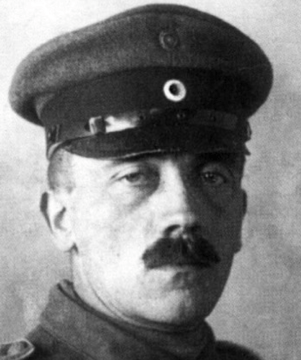Matt Taibbi in his Substack Newsletter:
 100 years ago yesterday — on July 29, 1921 — Adolph Hitler was elected leader of the Nationalist Socialist German Workers’ Party, later known as the Nazi Party. The combustible Army corporal succeeded the party’s original leader, Anton Drexler, whom Hitler originally been sent to spy on, but whose ideas he came to admire (he may even have shaved his mustache to emulate his predecessor). The 533-1 delegate vote set in motion a series of events that would dominate the next two and a half decades of world history.
100 years ago yesterday — on July 29, 1921 — Adolph Hitler was elected leader of the Nationalist Socialist German Workers’ Party, later known as the Nazi Party. The combustible Army corporal succeeded the party’s original leader, Anton Drexler, whom Hitler originally been sent to spy on, but whose ideas he came to admire (he may even have shaved his mustache to emulate his predecessor). The 533-1 delegate vote set in motion a series of events that would dominate the next two and a half decades of world history.
A young Jewish Internet commentator named Manny Marotta wanted to call attention to the date, for educational purposes. Marotta has been maintaining popular accounts on both Twitter and Instagram called 100 Years Ago Live. His simple, clever, and enlightening mission is to describe history as an actual contemporary might have, in the language of modern social media tools. It’s popular, earning 26,000 followers on Twitter.
Marotta’s accounts remind us that the past was once news, that stories we now remember as ossified, fixed narratives captured in black and white were once fresh, suspenseful events, that filled contemporaries with excitement, and uncertainty.
More here.

 W
W The list of mycologists whose names are known beyond their fungal field is short, and at its apex is Paul Stamets. Educated in, and a longtime resident of, the mossy, moldy, mushy Pacific Northwest region, Stamets has made numerous contributions over the past several decades— perhaps the best summation of which can be found in his 2005 book Mycelium Running: How Mushrooms Can Help Save the World. But now he is looking beyond Earth to discover new ways that mushrooms can help with the exploration of space.
The list of mycologists whose names are known beyond their fungal field is short, and at its apex is Paul Stamets. Educated in, and a longtime resident of, the mossy, moldy, mushy Pacific Northwest region, Stamets has made numerous contributions over the past several decades— perhaps the best summation of which can be found in his 2005 book Mycelium Running: How Mushrooms Can Help Save the World. But now he is looking beyond Earth to discover new ways that mushrooms can help with the exploration of space. The Log Lady of the Quiet Zone lived a few miles away and had the mysterious power to “detect” WiFi, cell signals, and other forms of electromagnetic radiation. I was told I might find the Log Lady at church—perhaps the only church in America quiet enough for her to attend.
The Log Lady of the Quiet Zone lived a few miles away and had the mysterious power to “detect” WiFi, cell signals, and other forms of electromagnetic radiation. I was told I might find the Log Lady at church—perhaps the only church in America quiet enough for her to attend. I WONDER HOW people will think of psychoanalysis after they see the show “Louise Bourgeois, Freud’s Daughter,” currently at the Jewish Museum in New York. Will it rise in their esteem, having fallen to the level of a silly, obsolete science, a worn-out, clichéd set of interpretations? Bourgeois’s relationship to psychoanalysis is rich, layered, and, importantly, long, as psychoanalysis is wont to be: beginning in 1951 with her treatment following her father’s death, lasting until 1985 with her psychoanalyst’s death. She calls it “a jip,” “a duty,” “a joke,” “a love affair,” “a bad dream,” “a pain in the neck,” and “my field of study.”1 It is, indeed, all of these things and more. And it is, in ways I think have been neglected or rarely glimpsed, also sculptural.
I WONDER HOW people will think of psychoanalysis after they see the show “Louise Bourgeois, Freud’s Daughter,” currently at the Jewish Museum in New York. Will it rise in their esteem, having fallen to the level of a silly, obsolete science, a worn-out, clichéd set of interpretations? Bourgeois’s relationship to psychoanalysis is rich, layered, and, importantly, long, as psychoanalysis is wont to be: beginning in 1951 with her treatment following her father’s death, lasting until 1985 with her psychoanalyst’s death. She calls it “a jip,” “a duty,” “a joke,” “a love affair,” “a bad dream,” “a pain in the neck,” and “my field of study.”1 It is, indeed, all of these things and more. And it is, in ways I think have been neglected or rarely glimpsed, also sculptural. Some years ago, I attended a conference featuring boldface names and their thoughts on the topic of the essay as art. At 39, I’d written three failed novels, and essays felt like the last form left to me. I was desperate for tips, tricks, and whatever writerly chum they throw to audiences at events like these.
Some years ago, I attended a conference featuring boldface names and their thoughts on the topic of the essay as art. At 39, I’d written three failed novels, and essays felt like the last form left to me. I was desperate for tips, tricks, and whatever writerly chum they throw to audiences at events like these. The arrow of time — all the ways in which the past differs from the future — is a fascinating subject because it connects everyday phenomena (memory, aging, cause and effect) to deep questions in physics and philosophy. At its heart is the fact that entropy increases over time, which in turn can be traced to special conditions in the early universe. David Wallace is one of the world’s leading philosophers working on the foundations of physics, including space and time as well as quantum mechanics. We talk about how increasing entropy gives rise to the arrow of time, and what it is about the early universe that makes this happen. Then we cannot help but connecting this story to features of the Many-Worlds (Everett) interpretation of quantum mechanics.
The arrow of time — all the ways in which the past differs from the future — is a fascinating subject because it connects everyday phenomena (memory, aging, cause and effect) to deep questions in physics and philosophy. At its heart is the fact that entropy increases over time, which in turn can be traced to special conditions in the early universe. David Wallace is one of the world’s leading philosophers working on the foundations of physics, including space and time as well as quantum mechanics. We talk about how increasing entropy gives rise to the arrow of time, and what it is about the early universe that makes this happen. Then we cannot help but connecting this story to features of the Many-Worlds (Everett) interpretation of quantum mechanics. Multilateralism has been on the defensive in recent years. In a global setting that is more multipolar than multilateral, competition between states seems to prevail over cooperation nowadays. However, the recent global agreement to reform international corporate taxation is welcome proof that multilateralism is not dead.
Multilateralism has been on the defensive in recent years. In a global setting that is more multipolar than multilateral, competition between states seems to prevail over cooperation nowadays. However, the recent global agreement to reform international corporate taxation is welcome proof that multilateralism is not dead. It is 1966 and I am sitting on a stool at the Burger King on Merritt Island, Florida, eating French fries. My view is Highway 520 and the cars speeding up to the rare stoplight just beyond where I sit. My father, my sister, and I have been to Cocoa Beach to swim and are on our way home. I always beg to stop at the Burger King. I am always famished after swimming and there is nowhere to eat on the beach. Also, we are not a fast food family so this is a treat, something my mother, who never goes to the beach, does not know about. I love how, after being at the beach, the French fries taste doubly salty.
It is 1966 and I am sitting on a stool at the Burger King on Merritt Island, Florida, eating French fries. My view is Highway 520 and the cars speeding up to the rare stoplight just beyond where I sit. My father, my sister, and I have been to Cocoa Beach to swim and are on our way home. I always beg to stop at the Burger King. I am always famished after swimming and there is nowhere to eat on the beach. Also, we are not a fast food family so this is a treat, something my mother, who never goes to the beach, does not know about. I love how, after being at the beach, the French fries taste doubly salty. For the first thirty years of his career, Kerry James Marshall was a successful but little known artist. His figurative paintings, drawings, sculptures, photographs, and videos appeared in gallery and museum shows here and abroad, and selling them was never a problem. He won awards, residencies, and grants, including a MacArthur Fellowship in 1997, but in the contemporary-art world, which started to look more closely at Black artists in the nineties, Marshall was an outlier, and happy to be one. He had an unshakable confidence in himself as an artist, and the undistracted solitude of his practice allowed him to spend most of his time in the studio. The curator Helen Molesworth told me that during the three years it took to put together “Mastry,” Marshall’s first major retrospective in the United States, which opened in 2016 at the Museum of Contemporary Art Chicago and travelled to the Metropolitan Museum of Art and the Museum of Contemporary Art, Los Angeles, “there were still people in the art world who didn’t know who he was.”
For the first thirty years of his career, Kerry James Marshall was a successful but little known artist. His figurative paintings, drawings, sculptures, photographs, and videos appeared in gallery and museum shows here and abroad, and selling them was never a problem. He won awards, residencies, and grants, including a MacArthur Fellowship in 1997, but in the contemporary-art world, which started to look more closely at Black artists in the nineties, Marshall was an outlier, and happy to be one. He had an unshakable confidence in himself as an artist, and the undistracted solitude of his practice allowed him to spend most of his time in the studio. The curator Helen Molesworth told me that during the three years it took to put together “Mastry,” Marshall’s first major retrospective in the United States, which opened in 2016 at the Museum of Contemporary Art Chicago and travelled to the Metropolitan Museum of Art and the Museum of Contemporary Art, Los Angeles, “there were still people in the art world who didn’t know who he was.” J
J Ever since 1796, when English scientist and physician Edward Jenner successfully inoculated an eight-year-old boy with cowpox to protect him from smallpox, vaccines have been a key tool for preventing disease. From smallpox to polio, diphtheria to COVID-19, vaccines have prevented more deaths from infectious disease than any other medical treatment.
Ever since 1796, when English scientist and physician Edward Jenner successfully inoculated an eight-year-old boy with cowpox to protect him from smallpox, vaccines have been a key tool for preventing disease. From smallpox to polio, diphtheria to COVID-19, vaccines have prevented more deaths from infectious disease than any other medical treatment. The show will be airing once a month, and I already have several episodes recorded. I am always interested in hearing pitches for new episodes, with guests who either have some weighty credentials in a given area (e.g., a biochemist who wants to address with me the question “What is life?”), or who have some demonstrable ability to speak about a topic in a compelling way (e.g., I’m recording an episode on friendship with someone whose credentials in this area are that he is my old old friend and I know him to be an excellent raconteur). [3QD Editor’s Note: the friend mentioned here happens to be yours truly—S. Abbas Raza]
The show will be airing once a month, and I already have several episodes recorded. I am always interested in hearing pitches for new episodes, with guests who either have some weighty credentials in a given area (e.g., a biochemist who wants to address with me the question “What is life?”), or who have some demonstrable ability to speak about a topic in a compelling way (e.g., I’m recording an episode on friendship with someone whose credentials in this area are that he is my old old friend and I know him to be an excellent raconteur). [3QD Editor’s Note: the friend mentioned here happens to be yours truly—S. Abbas Raza] The coronavirus sports a luxurious sugar coat. “It’s striking,” thought Rommie Amaro, staring at her computer simulation of one of the trademark spike proteins of SARS-CoV-2, which stick out from the virus’s surface. It was swathed in sugar molecules, known as glycans.
The coronavirus sports a luxurious sugar coat. “It’s striking,” thought Rommie Amaro, staring at her computer simulation of one of the trademark spike proteins of SARS-CoV-2, which stick out from the virus’s surface. It was swathed in sugar molecules, known as glycans.